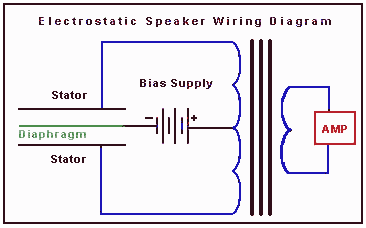Introduction
Most consumers have never seen an electrostatic
speaker, even though they were marketed way back in the 1930's.
The reason for this is that electrostatic speakers, or
ESLs, are rather esoteric, meaning that they are not your garden variety
speaker, and are not for everyone. Ironically, every woman I have talked to
said they love the look of ESL speakers. It's probably because they are slim
and transparent, so they don't overpower the room decor. Thus, they have a
high SAF (Spouse Acceptance Factor).
ELSs are usually very expensive, because
they are not made in great quantities, and they have to be relatively large
due to the membrane that moves the air not having a lot of excursion. They
also need a wall AC connection to power the supply that provides an
electrostatic charge on the membrane. So, you can't just plop them down
anywhere in your listening room. Lastly, they really need to be out from the
wall, because they are dipoles, meaning that the sound comes out the back
just as much as it does out the front.
The Design
There have been a number of ESL manufacturers over the
years, including KLH. I remember when I was in high school, and I heard a
pair of KLH ESLs. They were the size of doors, and were being driven by
McIntosh power amplifiers. I wanted a pair of them so bad, I could taste it,
but alas, high school students don't have much cash to buy such things, and
they were $1,500 a pair. Rotten luck it was.
These days, there are only a handful of companies that
market ESLs. In the US, Martin Logan is perhaps the best known. Innersound also sells
them, and we reviewed their complete
ESL system in 2005. In Europe, where it is based (The Netherlands), Final Sound is very well known.
In Europe, where it is based (The Netherlands), Final Sound is very well known.
ESLs work in the following way. A thin plastic membrane,
or diaphragm,
is suspended between two metal perforated "stators". An electrostatic charge
is placed on the membrane on the order of several thousand volts. The audio
signal passes through a transformer that increases its voltage, also to
several thousand volts. As the audio signal changes from plus to minus on
the front vs. the rear stators, the charged membrane is attracted to, or
repelled from, the stators. The membrane moves air through the stators, and
this produces the music that you hear.
Final Sound has made some changes in the ESL design by
sending the audio signal to the membrane, while the stators have the static
charge, positive on one side and negative on the other.
Here is a PDF white paper that describes their technology. This is the
exact opposite of conventional ESL designs, where the static charge is on
the membrane, and the audio signal is applied to the stators.
One of the advantages of this new design is that it does not take as
much amplifier power to drive them, and this is important, because ESLs have
been notorious for needing lots of amplifier power. In the case of the Final
Sound 400i's, which is the model being reviewed here, I found that 10 watts
per channel filled the room with sound. Other claimed advantages include
lower distortion and greater detail. Lastly, the design allows for smaller
electronics (the transformer), which reduces manufacturing cost.
Now that does not mean you can drive them with just any
old amplifier. The reason for this is that ESLs are notorious for something
else, namely having low impedance. Usually, they will be 4 ohms, or lower,
at some frequencies. So, you still need a good amplifier that will work at
low impedance, but it just does not have to be a high powered one anymore.
So then, the 400i is the smallest of Final Sound's
floor-standers. It is 48" high, 10" wide, and 6" deep. The speakers come
with an oval metal plate that you bolt to the base, and then it is ready for
placement. As I mentioned, ESLs need an AC wall supply. That has not
changed, and the Final Sound ESLs use wall warts that connect to the back of
the 400i. This supplies 12 volts to the internal power supply which raises
it to several thousand volts for charging the membrane.
Other models include the 600i, which is 61" high, the
1000i, at 74" high, and the 1400i, which is 80" high. Yup, 80". That is 6
feet 8 inches. As I mentioned, ESLs need to be big, because that membrane
does not move very far forward and backward. So, the large membrane, with
lots of square inches of surface area, will move enough air that you can get
high SPL when you want it.
All of the models have a configuration where the panels
are divided into vertical sections, each of which reproduces a specific
frequency range.
So, why are 48" models even manufactured? Well, not
everyone can fit an 80" tall speaker in their listening space. Smaller ones
will work fine if you add a good subwoofer (Final Sound offers several
models), and if you are putting them into
a home theater, it is even more useful if you can get five ESLs that are
reasonable in size, namely about 48" high (or wide, in the case of the
center channel).
If a good subwoofer can take up the slack at the low
frequencies, why build big ESLs at all? The answer is that a cone speaker is
much different than an ESL panel, and purists want to have all the
frequencies coming from the ESL, rather than having the mids and highs
coming from a membrane, and the lows coming from a cone.
But, we are not covering the 80" version here. This is
about testing a pair of ESLs that would fit in any listening space, and
discussing what the compromises are.
Click Here to Go
to Part II.